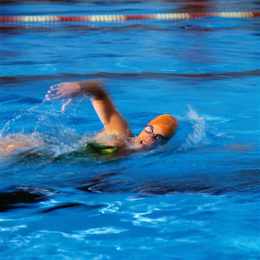pylon
Question
In regards to NFHS football rules, if a runner is carrying the ball in bounds and (a) dives toward the pylon and hits the front of the pylon or (b) is in bounds and while being tackled extends the ball and hits the front of the pylon is it a touchdown or out of bounds? If it is out of bounds where would the ball be spotted?
Answer
Don
I apologize on the delay in answering I did not see this question in my notifications. Let me take you through the rule and thought process to help you understand rather than a yes or no reply.
The Pylon is out of bounds. So when the ball touches the pylon it is out of bounds - A ball that touches a pylon is out of bounds (whether the inside edge or outside edge or anywhere) behind the goal line. The NFHS Rules state if the ball touches the pylon it is OB behind the goal line NFHS Rule 4-3-2
So, When a ball carrier dives or jumps toward the sideline and is airborne as he crosses the sideline, forward progress is determined by the position of the ball as it crosses the sideline. Under NFHS rules the goal line is extended ONLY when a runner is in possession of a live ball while touching the ground in bounds (Rule 2-27-3).
Examples - The ball, in possession of airborne ball carrier A21, crosses the sideline above the one-yard line, penetrates the plane of the goal line extended and is then declared dead out of bounds in possession of A21. RULING: Ball is declared out of bounds at the one-yard line
This is from the NFHS Case Book - 2.26.3 SITUATION: Runner A1 is advancing towards B抯 goal line and is very near the sideline. (a) A1 advances into B抯 end zone while holding the ball outside the sideline plane; or (b) A1 dives toward the end zone, but is hit by B1 which causes him to land out of bounds beyond the goal-line extended. A1抯 last contact with the ground was short of the goal line. In both cases the ball breaks the plane of B抯 goal-line extended. RULING: In (a), it is a touchdown because A1 was touching inbounds when the ball broke the plane of the goal-line extended. However, in (b) since A1 was not touching inbounds and was short of the goal line when he was hit, it is not a touchdown even though the ball did break the goal-line plane extended. The ball is spotted at the inbounds spot on the yard line where the foremost point of the ball crossed the sideline plane when A1 was driven out of bounds.
Guidelines for Plays Involving the Pylon
General Rules
? If a ball carrier advancing from the field of play has possession of a live ball when it penetrates the opponent抯 goal line he shall be awarded a score.
? The pylon is in the end zone but is considered out of bounds.
? A player who touches a pylon is out of bounds.
? A ball that touches the pylon is out of bounds behind the goal line.
Philosophy
? A runner is a player with possession of a live ball advancing towards his opponent抯 goal line on his feet.
? An airborne player is one who voluntarily leaves his feet and dives or lunges in an attempt to get to his opponent抯 goal line.
? A runner who is hit by an opponent causing him to become airborne is still considered a runner and the rules regarding a runner at the pylon will still apply.
Play Situations ?Score
? Runner crosses goal line with possession of the ball. Both runner and ball cross inside the pylon ?Score
? Runner crosses goal line with possession of the ball. Runner is inside the pylon and ball is outside the pylon ?Score
? Runner crosses goal line extended with possession of the live ball. Runner crosses over the pylon and ball is outside the pylon ?Score
? Consider this play at the right-hand goal-line pylon: The ball carrier has the ball in his right hand. His left foot hits inbounds at the one-foot line, he sticks the ball across the plane of the goal line extended (i.e., outside the pylon) and then his right foot hits the ground to the right of the pylon. In this case the live ball has penetrated the goal-line plane extended. -- 琒core
? Runner gets hit near the goal line causing him to leave his feet. Both runner and ball cross inside the pylon ?Score
? Runner gets hit near the goal line causing him to leave his feet. Runner crosses goal line extended over the pylon and ball crosses outside the pylon ?Score
? Player dives and crosses goal line with possession of the ball. Both player and ball cross inside the pylon ?Score
? Player dives and crosses goal line with possession of the ball. Both player and ball cross over the pylon ?Score
? Player dives and crosses goal line with possession of the ball. Player crosses outside pylon and ball crosses inside the pylon ?Score
? Player dives and crosses goal line with possession of the ball. Player crosses outside pylon and ball crosses over pylon ?Score
Play Situations ?No Score
? Play at the right-hand goal-line pylon: Runner crosses goal line extended with possession of the ball. Both runner and ball cross outside the pylon ?No Score
? The ball carrier has the ball in his right hand. His left foot hits inbounds at the one-foot line, his right foot hits the ground to the right of the pylon(OB) then he sticks the ball across the plane of the goal line extended (i.e., outside the pylon). In this case a dead ball has penetrated the goal-line plane extended. ?No Score
? Runner gets hit near the goal line causing him to leave his feet. Both runner and ball cross goal line extended outside the pylon. Runner hits OB/Pylon before the ball penetrates the goal line extended ?No Score
? Player dives (airborne) and crosses goal line extended with possession of the ball. Both player and ball cross outside the pylon ?No Score
? Player dives (airborne) and crosses goal line extended with possession of the ball. Player crosses inside pylon and ball crosses outside the pylon ?No Score
? Player dives (airborne) and crosses goal line extended with possession of the ball. Player crosses over pylon and ball crosses outside the pylon ?No Score
The word 揳irborne?is restricted to those cases where the runner voluntarily leaves his feet and dives or lunges.
So in your question (a) TD the ball breaks the plane of the GL and the ball is OB in player possession behind the goal line; in question (b) short of the goal line if he is down before the ball touches the pylon. If the ball touches the pylon first then a TD. If short spot where dead short of the GL.
College football clock operating Mechanics
waiting on the defense


